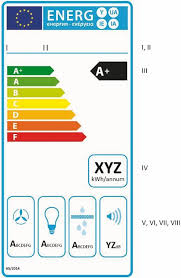Methodology
Topten.eu presents four categories of the most energy efficient range hoods that are available in at least one European country:
- Island range hoods
- Wall range hoods
- Telescopic range hoods
- Integrated range hoods
Technical criteria
In order to qualify for topten.eu range hoods must meet the following criteria:
- Lighting efficiency class according to EU energy label: at least A
-
Energy efficiency class according to EU energy label: at least A+
- Grease filtering efficiency class according to EU energy label: at least C
- Fluid dynamic efficiency class according to EU energy label: at least A
Suppliers who are not able to provide these values cannot claim to have their appliances presented on topten.eu
Data sources
Order of presentation
The products are ordered according to their electricity costs. The order can be changed individually by clicking on the head of the tables.
Glossary
Brand, Model and Similar Models
Brand and model names. Products of similar construction and identical technical values are displayed only once, the similar models’ names are listed below. A click on the column of a product shows the detailed view.
Electricity costs
Assumptions:
- Service life of product: 15 years
- Annual energy consumption as declared on EU energy label
- Tariff of electricity: 0.30 € /kWh
Width
Dimensions of the model in cm
Extraction
Indication if extraction mode is possible
Recirculation
Indication if recirculation mode is possible
Energy
Annual energy consumption in kWh according to the declaration on the EU energy label
Energy efficiency class
According to the Energy labelling regulation No 65/2014.
The classification of the energy label is based on the energy efficiency index (EEI). The energy efficiency classes range from A+++ (most efficient) to G (least efficient)
| Class
|
EEI
|
Energy Label
|
A+++
|
EEI < 30
|

|
| A++
|
30 ≤ EEI < 37
|
| A+
|
37 ≤ EEI < 45
|
| A
|
45 ≤ EEI < 55
|
| B
|
55 ≤ EEI < 70
|
| C
|
70 ≤ EEI < 85
|
| D
|
85 ≤ EEI < 100
|
| E
|
100 ≤ EEI < 110
|
| F
|
110 ≤ EEI < 120
|
| G
|
EEI ≤ 120
|
Fluid dynamic efficiency class
The EU energy label defines 7 different classes: from A (most efficient) to G (least efficient).
The fluid dynamic efficiency is based on the flow rate, the static pressure difference and the electric power input of the range hood at best efficiency point.
Lighting efficiency class
The EU energy label defines 7 different classes: from A (most efficient) to G (least efficient).
Lighting efficiency means the ratio between the average illumination of the lighting system of the range hood and the power of the lighting system in lux/W.
Grease filtering efficiency class
The EU energy label defines 7 different classes: from A (most efficient) to G (least efficient).
Grease filtering efficiency means the relative share of grease retained within the range hood grease filters.
Extraction rate
The amount of air in m3 that can be extracted in one hour at the highest setting for normal use
Noise Level
Noise value in dB(A) at the highest setting for normal use
Available in countries
This item displays the availability of models in European countries according to producers’ declarations, national Topten sites and other data bases such as EPREL. "EU" means all countries of the European Union. However, the availability is sometimes difficult to define precisely, as it can depend on marketing and sales decisions by retailers and national manufacturing units. "On demand" means that producers could not indicate the availability and that consumers have to ask in their countries on their own. The country codes are according to ISO.
Infoplus
Publications
Standards and Labels
- Commission delegated regulation (EU) No 65/2014 of 1 October 2013 supplementing Directive 2010/30/EU of the European Parliament and of the Council with regard to the energy labelling of domestic ovens and range hoods
- Commission regulation (EU) No 66/2014 of 14 January 2014 implementing Directive 2009/125/EC of the European Parliament and of the Council with regard to ecodesign requirements for domestic ovens, hobs and range hoods
- Amendment regarding Online Energy Labels: Regulation No. 518/2014
- Directive 2010/30/EU on the indication by labelling and standard product information on the consumption of energy and other resources by energy-related products (recast)
Links
- Energy efficiency measures by the European Commission
- The European council for an energy efficient economy eceee provides a status overview on all products in the Ecodesign & Energy Labelling process
- Coolproducts informs about the EU ecodesign process. It is a coalition of NGOs' campaign for a stronger, fast Ecodesign Directive to save the climate and money
- ECOS (Ecostandard) is an international NGO with a network of members and experts advocating for environmentally friendly technical standards, policies and laws
- EPREL (European Product Registry for Energy Labelling) is the European product database. Products with an energy label are registered in EPREL in order to provide consumers with detailed product information.
Producers and retailers are kindly asked to contact info(at)topten.info to inform about more products meeting the Topten selection criteria.
11/2022 Gross, Bush
 Miele DA 9298W
Miele DA 9298W berbel BLB 60 FL
berbel BLB 60 FL WESCO EVM 211-55
WESCO EVM 211-55 Miele DA 6999 W
Miele DA 6999 W Miele DA 5798 W
Miele DA 5798 W